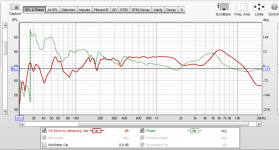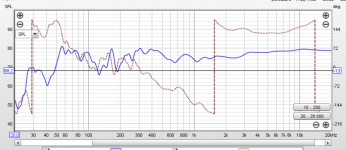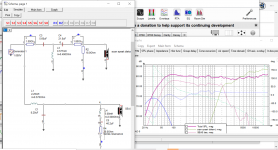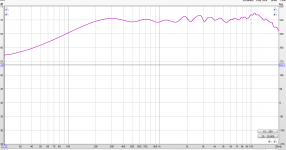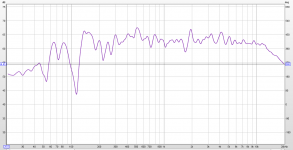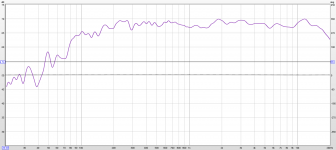Hello
As you can see, my measurements look really bad.
These are made with REW, calibrated mic, focusrite sound card and a good amplifier.
The element is a SEAS L19 bass in a 19 liter box with bass reflex.
As you can see, it is very messy in the lower part (even above 200Hz).
does anyone have any idea what I'm doing wrong?
Is it the boxes or the measurements I make wrong?
greetings
fredrik
As you can see, my measurements look really bad.
These are made with REW, calibrated mic, focusrite sound card and a good amplifier.
The element is a SEAS L19 bass in a 19 liter box with bass reflex.
As you can see, it is very messy in the lower part (even above 200Hz).
does anyone have any idea what I'm doing wrong?
Is it the boxes or the measurements I make wrong?
greetings
fredrik
Attachments
Hi
This is made in a room. Is it the room or the box that makes the big peeks in the low section?
I have made a crossover filter in LSPcad using a trace program and used the manufacturer's measurements. but their curves are from a closed 12 liter box. Mine is a bass reflex of 19 liters.
It sounds perfectly okay but I lack life in the middle register. See the graph for calculated representation with the manufacturer's curves (via trace).
Someone who has a hint on what might be wrong. attach measured curves via REW and filter drawing.
with kind regards
Fredrik
This is made in a room. Is it the room or the box that makes the big peeks in the low section?
I have made a crossover filter in LSPcad using a trace program and used the manufacturer's measurements. but their curves are from a closed 12 liter box. Mine is a bass reflex of 19 liters.
It sounds perfectly okay but I lack life in the middle register. See the graph for calculated representation with the manufacturer's curves (via trace).
Someone who has a hint on what might be wrong. attach measured curves via REW and filter drawing.
with kind regards
Fredrik
Attachments
It is the room. Do a search on room nodes. In fact one of the things you can do with REW is simulate where those dips and peaks will be when you enter your room dimentions and the placement of the speakers. You should find they line up reasonably closely with what you are getting.
With gating you can reduce the effect on your measurement with the sacrifice of losing low end information. You will be lucky if you can get anything useful below say 300-400Hz in room, unless you have a big room and high ceilings.
Tony.
With gating you can reduce the effect on your measurement with the sacrifice of losing low end information. You will be lucky if you can get anything useful below say 300-400Hz in room, unless you have a big room and high ceilings.
Tony.
Here is a comparison of the same speaker in room, 1st taken at 1M with gating at 3ms 2nd taken at the listening position, no gating and 12th octave smoothing.
3rd pic is same speaker measured outside, no gating 1/12th octave smoothing.
Tony.
3rd pic is same speaker measured outside, no gating 1/12th octave smoothing.
Tony.
